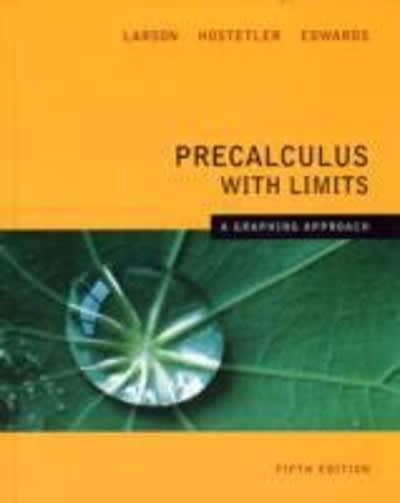Question
(N1)Marginals: The marginals are useful tools in investigating the rates of change of profit (), revenue () and cost () with respect to the number
(N1)Marginals: The marginals are useful tools in investigating the rates of change of profit (), revenue () and cost () with respect to the number () of goods sold. Using speed as an example, if we observe a projectile travelling at a speed of 50 feet per second, we feel relatively safe estimating the projectile would travel approximately 50 feet in the next second, but it is NOT SAFE to extrapolate and say the projectile will travel 50 60 = 3000 feet in the next minute because the speed can change. Similarly, marginal profit (()), marginal revenue (()) and marginal cost (()) give the approximate change in profit, revenue, and cost for AN (not each) additional unit sold!
Example 1: Mrs. Stark has a business selling bacon to her neighbors. She wants to study the effect of pricing on her bacon serving sales. Let's use to denote the number of servings she sells each month and to denote the price per serving. She is currently selling = 120 at = $7 each. She estimates (based on her current customers) that she can sell = 100 servings if she charges = $8 per serving.
(a) Assume the demand equation is linear. Find an expression for the demand equation. (i.e. write = + )
(b) Find her monthly revenue as a function of !
(c) Her monthly cost is () = 100 + 3. Find her monthly profit as a function of .
(d) Find the marginal profit function ().
(e) Mrs. Stark is currently selling = 120 servings a month. Evaluate () at = 120. Be sure to include the units!
(f) Explain the meaning of the numerical value in (e). Based on this explanation, do you think it is wise for Mrs. Stark to increase her production? (ie try to sell more servings) Why or why not?
(N2)Cost Functions: We define () to be the total cost of producing goods. We are also familiar with the marginal cost function () (i.e. the derivative of the cost function). We can also define an average cost function, we write C( q) (read C bar) for the average cost function. For example, if (20) = 500,
then (20) = 500 = 25 (i.e. if it costs $500 for 20 goods then each cost $25 on average). 20
Suppose the total cost in dollars to produce goods is given by the following function
() = 302 + 500. (It's fraction)
+2
(a) Find the total cost for producing 10 goods.
(b) Find the average cost per good when producing 10 goods. Be careful with the units!
(c) Find an expression for the average cost function!
(d) Use the quotient rule to find an expression for the marginal cost function (). There is no need to simplify your answer!
(e) What is the marginal cost at a production level of = 10 units? Be careful with the units!
(f) Based on your answers in (b) and (e) do you expect the average cost to increase or decrease if we increase production to = 11 units? Why? Note: The goal here is to UNDERSTAND the relationship between the average and marginal cost functions!
Step by Step Solution
There are 3 Steps involved in it
Step: 1

Get Instant Access to Expert-Tailored Solutions
See step-by-step solutions with expert insights and AI powered tools for academic success
Step: 2

Step: 3

Ace Your Homework with AI
Get the answers you need in no time with our AI-driven, step-by-step assistance
Get Started


